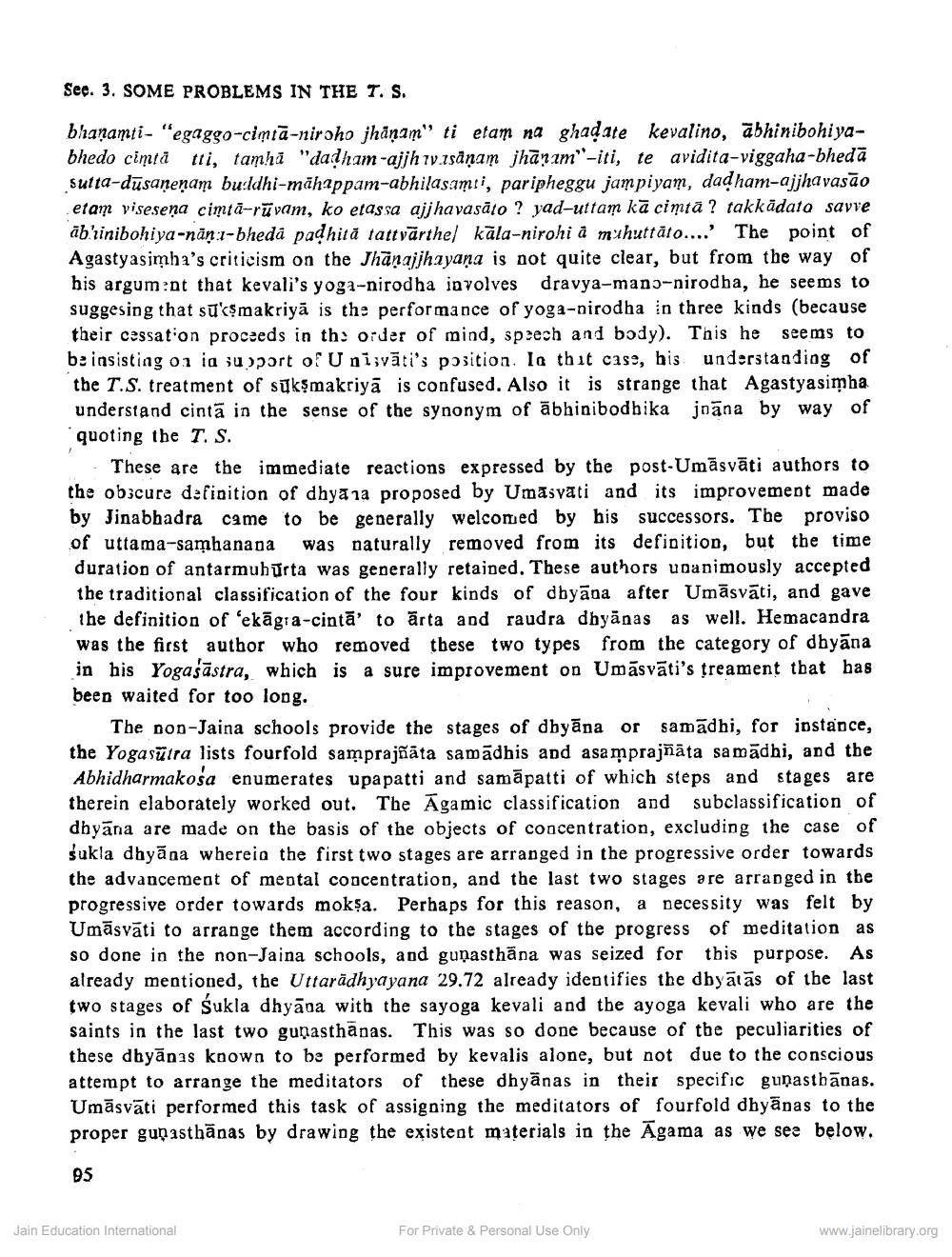________________
See. 3. SOME PROBLEMS IN THE T. S.
bhanamti- "egaggo-cimtā-niroho jhanam' ti etam na ghadate kevalino, ābhinibohiyabhedo cimtă tri, tamhā "dadham-ajjh wv.isāņam jhārım"-iti, te avidita-viggaha-bhedā sutta-dūsaņenam buldhi-māhappam-abhilasımıi, paripheggu jampiyam, dad ham-ajjhavasão etam viseseņa cimtā-rūvam, ko etassa ajj havasāto ? yad-uttam kā cimtā ? takkādato savve āb'rinibohiya-nana-bheda padhită tattvārthel kala-nirohi à muhuttăto.... The point of Agastyasimha's criticism on the Jhānajjhayana is not quite clear, but from the way of his argument that kevali's yoga-nirodha involves dravya-mang-nirodha, he seems to suggesing that sūksmakriya is the performance of yoga-nirodha in three kinds (because their cessation proceeds in th: order of mind, speech and body). This he seems to be insisting on in suport of Uni;vāti's position la that case, his understanding of the T.S. treatment of sūksmakriya is confused. Also it is strange that Agastyasimha understand cintā in the sense of the synonym of ābhinibodbika jnana by way of quoting the T.S.
These are the immediate reactions expressed by the post-Umāsvāti authors to the obscure definition of dhyana proposed by Umāsvati and its improvement made by Jinabhadra came to be generally welcomed by his successors. The proviso of uttama-samhanana was naturally removed from its definition, but the time duration of antarmuburta was generally retained. These authors unanimously accepted the traditional classification of the four kinds of dhyāna after Umāsvāti, and gave the definition of 'ekāgia-cintā' to ārta and raudra dhyānas as well. Hemacandra was the first author who removed these two types from the category of dhyāna in his Yogašāstra, which is a sure improvement on Umāsvāti's treament that has been waited for too long.
The non-Jaina schools provide the stages of dhyāna or samadhi, for instance, the Yogasutra lists fourfold samprajñāta samādhis and asamprajñāta samādhi, and the
Abhidharmakośa enumerates upapatti and samāpatti of which steps and stages are therein elaborately worked out. The Āgamic classification and subclassification of dhyāna are made on the basis of the objects of concentration, excluding the case of sukla dhyāna wherein the first two stages are arranged in the progressive order towards the advancement of mental concentration, and the last two stages are arranged in the progressive order towards moksa. Perhaps for this reason, a necessity was felt by Umāsvāti to arrange them according to the stages of the progress of meditation as so done in the non-Jaina schools, and gunasthāna was seized for this purpose. As already mentioned, the Uttarādhyayana 29.72 already identifies the dhyālās of the last two stages of Sukla dhyāna with the sayoga kevali and the ayoga kevali who are the saints in the last two gunasthānas. This was so done because of the peculiarities of these dhyānas known to be performed by kevalis alone, but not due to the conscious attempt to arrange the meditators of these dhyānas in their specific gunasthānas. Umāsvāti performed this task of assigning the meditators of fourfold dhyānas to the proper gun asthānas by drawing the existent materials in the Āgama as we see below.
95
Jain Education International
For Private & Personal Use Only
www.jainelibrary.org




